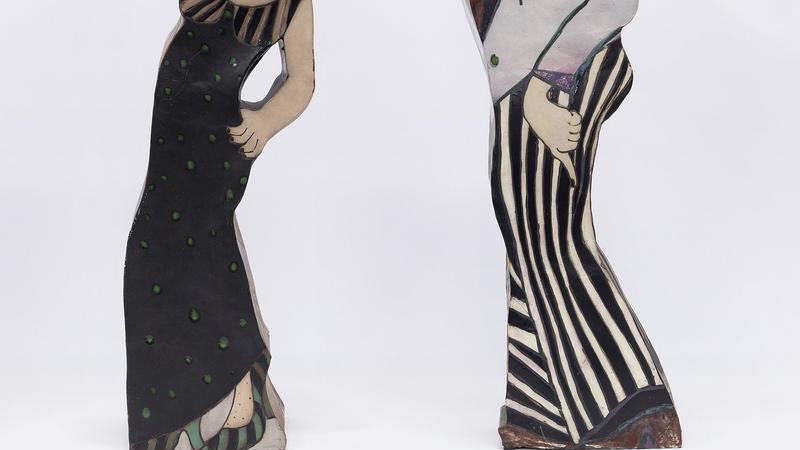My enthusiasm for pockets has never failed to surprise the men who overhear it. They respond as if it is I, not the pocket, who is unusual. A pocket, they seem to think. So pedestrian. A pocket! they seem to think. My good God, the things that get women excited.
And yet, as so many people who browse women’s clothing racks trying to robe themselves know, to sink your hands into that wide, wonderful space of an open pouch — especially in a dress! — is so far from the norm, it feels almost sneaky. Which, of course, is no accident. Like so much else masquerading as ordinary in this world, pockets are politics. Pockets are privilege. Since their beginnings, pockets have been symbols of power to those who hoard it. To the rest of us, they’ve been like arm holes or waistbands — things that make a garment useful. Or, they could have been, had it not been for the centuries-long fight to preserve the pocket for the few.
Hannah Carlson’s Pockets: An Intimate History of How We Keep Things Close, reveals these open secrets, and more. In a quest to understand our politics through our fashion, Carlson traces the history of the pocket, from the anxieties it tore open when pockets were first stitched in (men’s) clothing five hundred years ago, to the defiance it signaled when W.E.B. Dubois casually rested his hand in inside of it.
The world — or rather, its men — feared what women, in particular, may be hiding in those pockets (suffragist pamphlets, in particular). The world continues to fear the pockets of others: to be Black or brown or poor, and to simultaneously have your hands in your pockets, can get you killed in any number of places.
When next I have the privilege of having pockets — and because I enjoy the freedom to use them without unduly risking my life — I’ll keep copy of Carlson’s book handy, tucked right inside one of those subversive pockets, so that next time I encounter male surprise at my delight, I don’t have to say more than two words: Read this.
—Jina Moore Ngarambe for Guernica
An 1862 article in Godey’s Lady’s Book, the most popular magazine of its time, declared that hands were “troublesome” and men, in particular, did “not know where to put them.” The author contended that in social settings women had “a permanent advantage over men:” handling accessories such as “the needle, the shuttle, or the fan” allowed them to “find something legitimate to do with their hands.” The requirement that a person remain in perfect command of their limbs remained a staple of advice books through the nineteenth century, with most strongly discouraging using the pocket as a refuge for the awkward man. (Women’s clothes at this time did not have pockets.)
The idea that resting one’s hands in a pocket was disrespectful derived from longstanding codes forbidding touching the body in public. In his influential Renaissance book of manners, Galateo (1556), Giovani Della Casa under the category of behavior to be “shunned” was every act “that brings to mind unpleasant matters.” As with many such regulations related to the body, concerns about hygiene and sexuality were intertwined. Della Casa determined that “it is an indecent habit practiced by some people, who, in full view of others, place their hands on whatever part of their body it pleases them.” In other words, hands had the ability to “[imply] something disgusting to [people’s] imaginations.”
With Darwin’s publication of The Expression of the Emotions in Man and Animals in 1872, conduct books began to reflect new concerns relating to the meaning of the body’s unconscious movements. Most expressive movements, Darwin claimed, were innate, inherited residues of movements useful for survival—as a sneer is the residual effect of baring the canine tooth. In Darwin’s view, discovering the natural state, though, did not lead one back to grace. Late nineteenth-century books began to characterize the wayward appendages as monstrous.
Keeping one’s hands in “utter subjection” involved “mastery.” The 1888 Social Mirror included self-help treatment in the form a first-person interior monologue. “If you feel the usual painful sensations coming on” after encountering a roomful of people, the writer advised that the man go through a checklist starting with the carriage of head and shoulders, proceeding to the limbs:
As for my feet and hands, if I resolutely keep them still, no attention will be drawn to them, but the moment I begin to shift them around in various positions I will become practically nothing but feet and hands, they will swell to grotesque and abnormal proportions, will take a sort of demoniac possession of me, and drive me, in the end, to complete distraction. NO, clearly I must master my feet and hands and keep them in utter subjection.
“It is not that his hands are larger than they should be,” reflected Mrs. M.L. Rayne in Gems of Deportment, “but they have the faculty of being in all places at once, and they do not seem to belong anywhere.” The etiquette books that explicitly referenced Darwin suggested that the men had regressed down the evolutionary ladder. Some men are so alienated from them that his hands appear to him to be the hands of another species: “Darwin is right. There are moments which come to a young man who doesn’t know what to do with his hands when he longs to climb a tree and be a monkey.”
It would not be until the twentieth century that the once-vulgar hands-in-pockets stance became something entirely different, now utilized by sleek metropolitans and outlaw rebels, hip-hop stars and major fashion conglomerates pushing blue jeans and underwear. Today we read a hand in pocket as relaxed and unpretentious, but for the awkward, pockets remain a refuge and a shelter.
Hannah Carlson’s book, Pockets: An Intimate History of How We Keep Things Close, is out this month from Algonquin Press.
